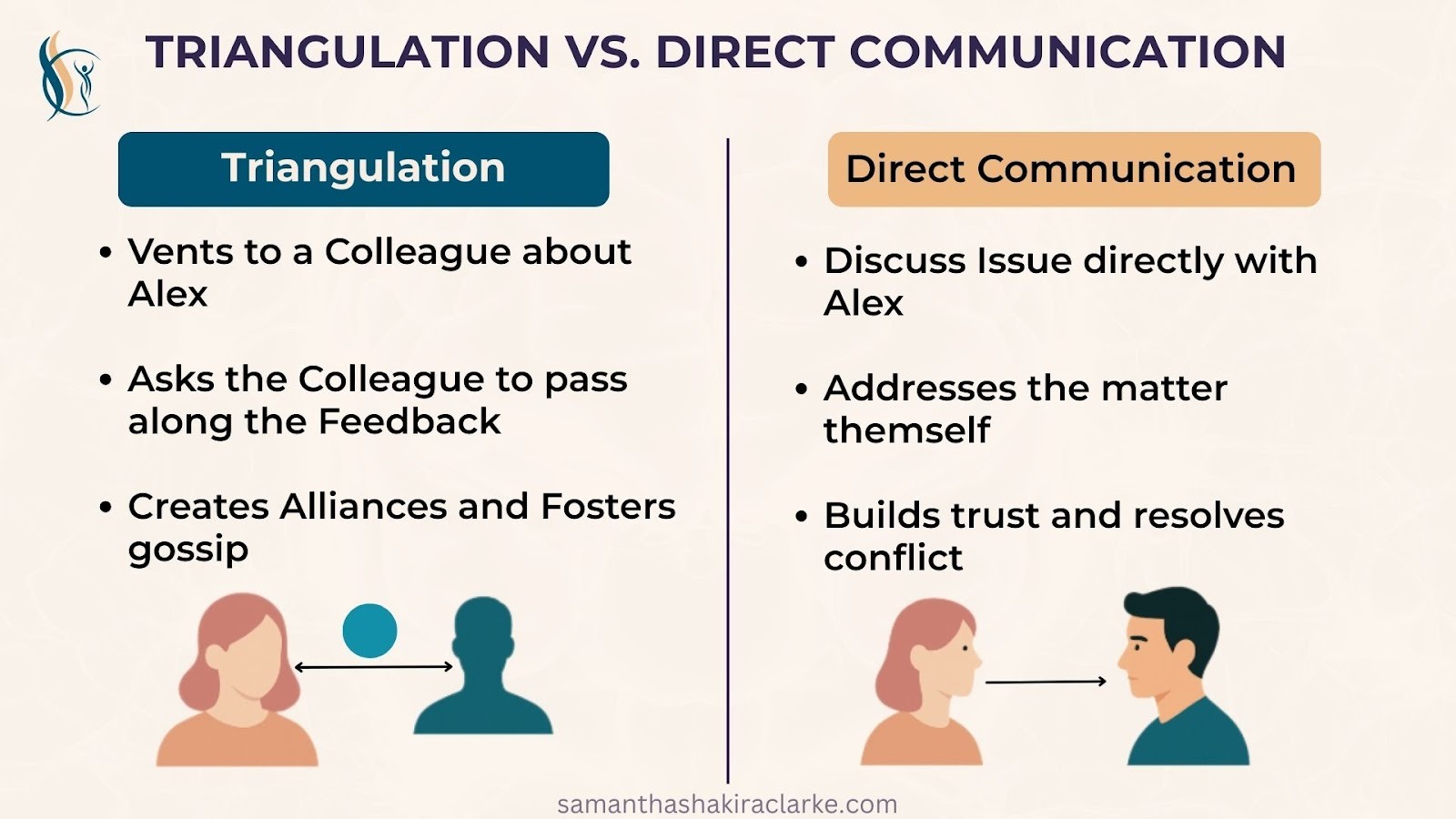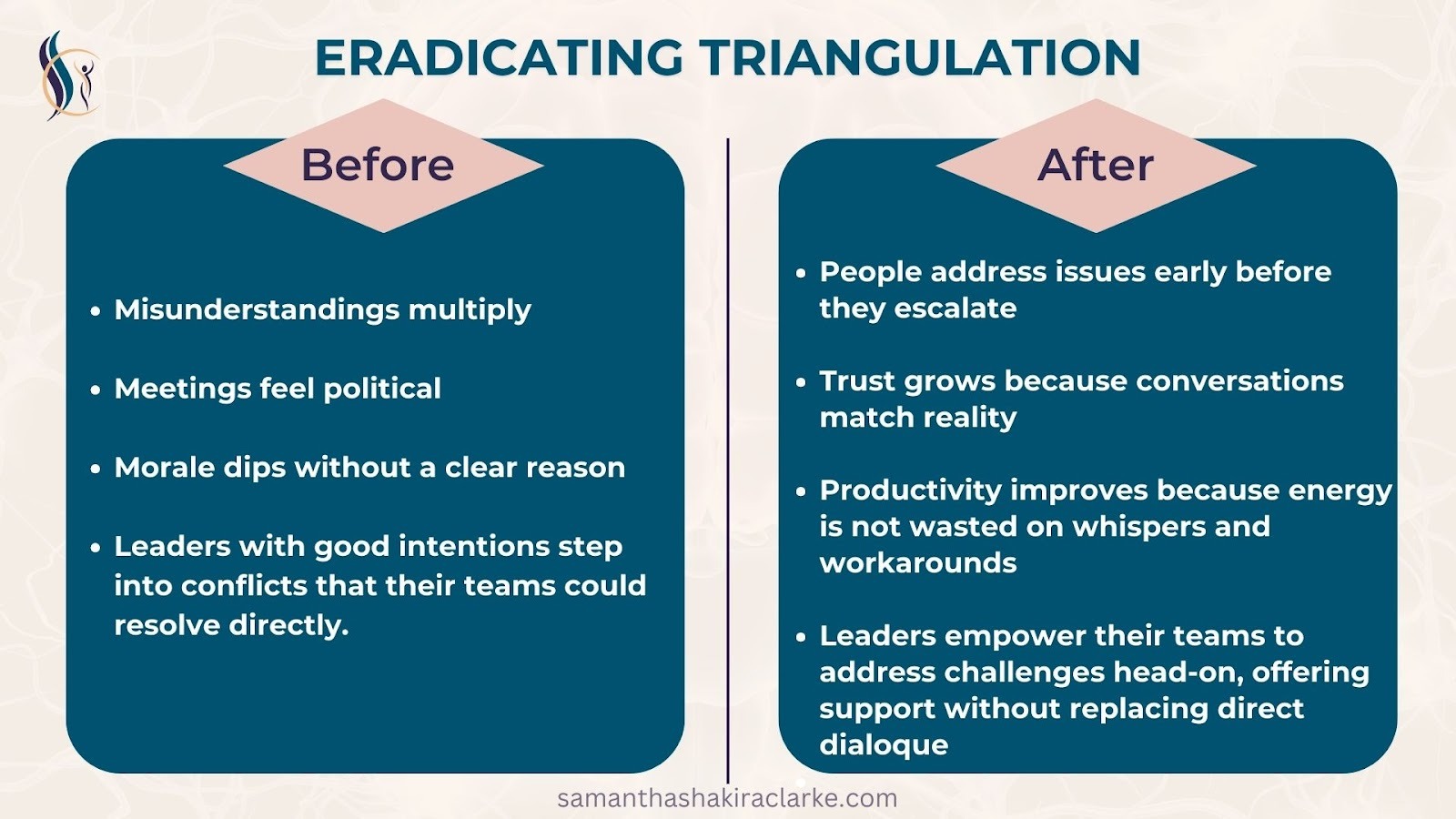On the surface, your team might look fine. Polite smiles in meetings, Slack channels humming along, coffee breaks shared. But under the surface, there is a quiet toxin that can dismantle trust faster than any failed project or bad quarter.
It is called triangulation. If you are serious about building a healthy workplace culture, it is worth knowing how to spot it, stop it, and replace it with something better.
What Is Triangulation?
In psychology, triangulation is when someone involves a third party in a conflict or communication that should be between two people. In the workplace, it often looks like:
- Venting to a colleague about someone instead of addressing them directly
- Asking one coworker to “pass along” feedback to another rather than going straight to the source
- Pulling in leadership to “back you up” before you have spoken to the person involved
It is not always malicious. Often it is just human discomfort with conflict. But whether intentional or not, it erodes trust and blocks resolution.
How Common Is triangulation?
More common than most leaders want to admit. It can happen in:
- Teams that think they are avoiding conflict but are actually avoiding resolution. This often happens when team members try to “keep the peace” by staying silent or moving conversations to side channels. Instead of a healthy debate, you get a surface-level harmony that hides unresolved tension, which eventually spills out in passive-aggressive behaviour or missed collaboration opportunities.
- Leaders who do not want to “hurt feelings” and delegate difficult conversations down the chain. While well-meaning, this creates a culture where direct communication is rare. Feedback gets watered down as it passes through intermediaries, and by the time it reaches the person who needs to hear it, the meaning (and sometimes the urgency) has been lost.
- New employees who do not feel safe to speak up directly so they go sideways instead. Without psychological safety, they may test the waters by sharing concerns with a peer rather than the person involved. This sideways communication can feel like harmless venting, but it lays the groundwork for gossip and erodes trust before the relationship even has a chance to build.
- Leaders who, with the best intentions, “go down the ladder” to hear every perspective and be available to everyone. While this can feel supportive, it can also unintentionally short-circuit healthy conflict resolution between direct reports. Instead of working through a disagreement together, employees learn to take issues up or sideways, waiting for the leader to manage it for them. Over time this can create dependency, slow decision-making, and weaken peer-to-peer trust.
A Harvard Business Review survey found that 58 percent of employees avoid addressing conflict directly and instead route it through a third party. That is a lot of conversations being filtered, distorted, and delayed.
Why It Is the Death of Healthy Culture
When triangulation is left unchecked:
- Trust Breaks Down – People start wondering what is being said about them when they are not there
- Gossip Grows – The grapevine becomes the default communication channel
- Issues Fester – Because the real conversation never happens
- Cliques Form – “Us vs them” dynamics replace collaboration
Healthy culture thrives on direct and respectful communication. Without it, your psychological safety net frays.
Real-World Examples
Pixar: Former president Ed Catmull famously implemented a “direct candor” policy in creative teams. Early in Pixar’s growth there were subtle signs of triangulation in production feedback. Animators were filtering critique through producers instead of each other. Once they instituted open feedback sessions, called Braintrust meetings, where notes were delivered directly in the room with the creator, quality skyrocketed and trust deepened.
Patagonia: Known for its strong culture, Patagonia trains managers to address conflict in the moment and directly rather than “taking it upstairs” unnecessarily. Internal reports show this reduced HR complaints and improved retention because small conflicts did not snowball.
A Tech Unicorn I Will Not Name: I worked with a fast-growing company where triangulation had become the default. Managers routinely acted as messengers between clashing team members. After a leadership offsite focused on direct feedback skills and a no-triangulation policy, cross-team trust scores improved by over 30 percent in the next engagement survey.
Why It Can Be Tricky to Eradicate
- It feels safer. Let’s be honest, direct conversations can be scary. You might worry about hurting someone’s feelings, sparking tension, or saying the wrong thing. Triangulation offers the illusion of safety because it lets you step sideways instead of leaning in. The trouble is, the temporary comfort comes at the expense of long-term trust.
- It can be disguised as helpfulness. “I’ll pass that along for you” sounds like support. It can even feel like you are protecting someone from a tough conversation. But in reality, you are sidestepping the real work of communication. The message gets filtered, and the person who needs to hear it loses the chance to respond in real time.
- Leaders model it without realizing. If a leader triangulates, even occasionally, the rest of the team will take it as permission to do the same. Over time, it quietly becomes the cultural norm,and once it is embedded in “how we do things here,” it takes more intentional effort to change.
- Unlearning is harder than learning. Many of us were raised in environments, at home, in school, or in early jobs where conflict was avoided, smoothed over, or handled indirectly. These patterns get wired into our habits. Choosing direct communication often means overriding years of learned behaviour, which requires both self-awareness and consistent practice.
What To Do Instead
- Name It
Bring the term “triangulation” into your team vocabulary. Once people can name a behaviour, they can catch it in action
- Use Direct Scripts
Give your team language to use, like:
- “I think this is a conversation you and Alex should have directly. I am happy to help you prepare”
- “Let’s get all of us in the same room so we can resolve this together”
- Model the Behaviour
Leaders need to go directly to the person involved every time and be transparent about it
- Train for Feedback Skills
Role-play giving and receiving feedback in low-stakes settings. The more practiced people are, the less scary it feels
- Create Safe Channels
Psychological safety is not just a buzzword. If employees know they will not be punished for respectful honesty, triangulation loses its appeal
The Before and After of Eradicating Triangulation
Triangulation is one of the quietest and most damaging patterns in workplace culture. Once you name it, model the alternative, and practice direct communication, it is also one of the easiest to transform. The payoff in trust, clarity, and collaboration is huge.
If your team has pockets of triangulation, you are not alone — it shows up in almost every workplace at some point. The good news is that it can be shifted quickly with the right awareness and skills.
If you would like support in equipping your leaders and teams with tools for direct, trust-building communication, let’s connect. I run interactive sessions that help organizations spot triangulation early, replace it with healthier patterns, and strengthen relationships at every level.
Book a discovery call here
 Book Now!
Book Now!



